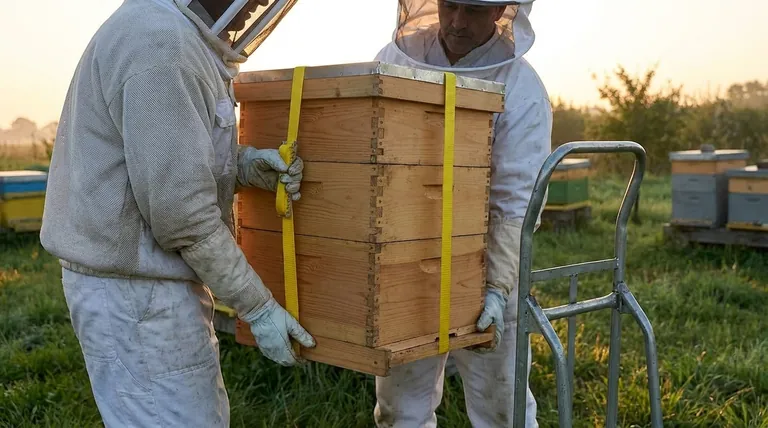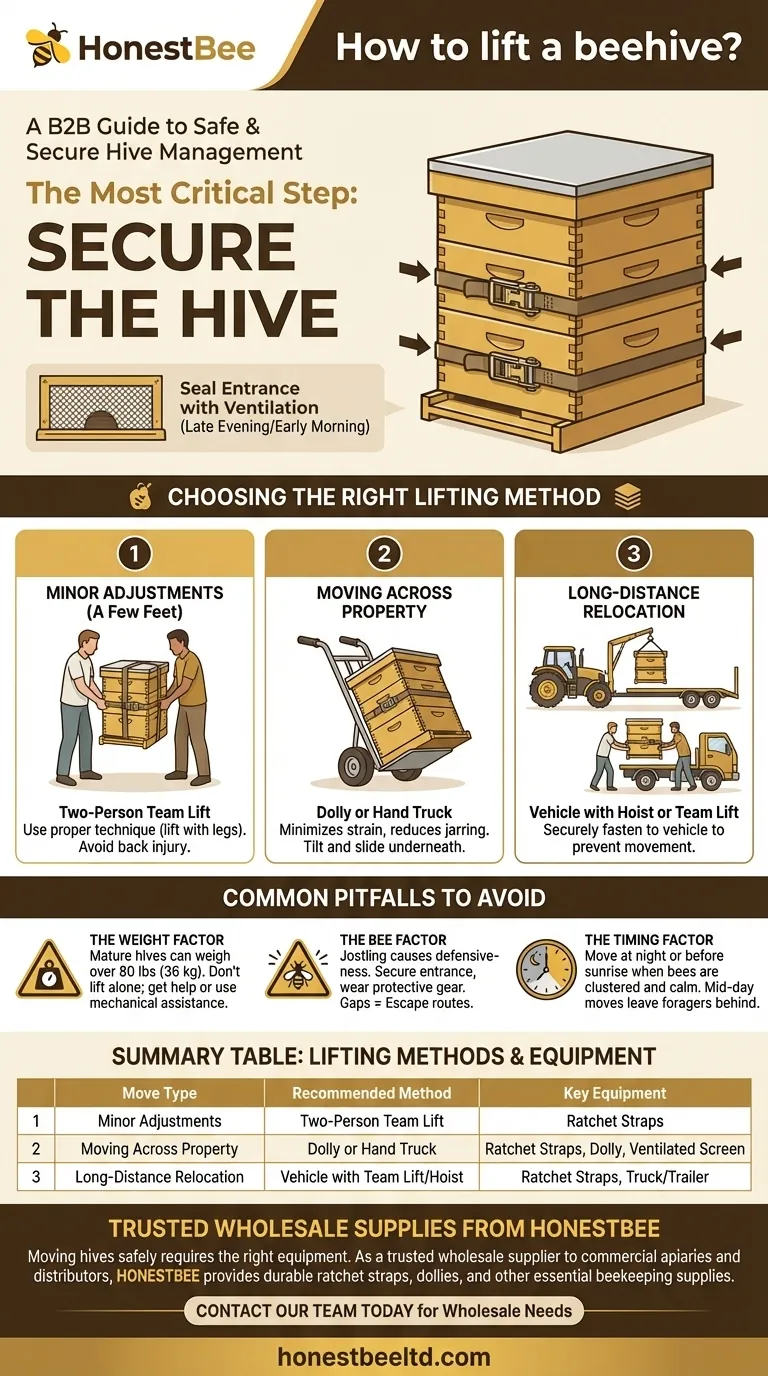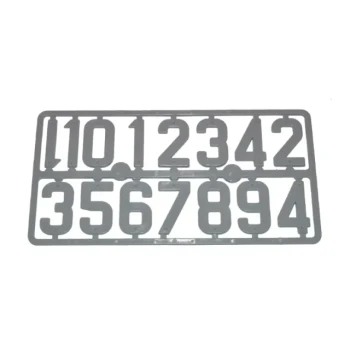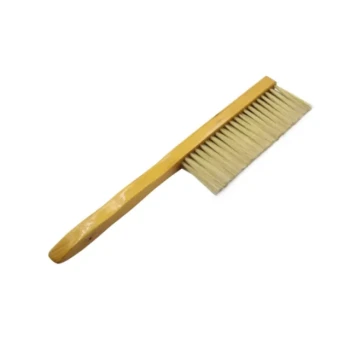To lift a beehive safely, you must first strap all its components—the lid, supers, and bottom board—together into a single, secure unit. For short distances, two people can use the straps as handholds or slide the hive onto a dolly. For longer moves requiring a vehicle, use a hoist or team lift the secured hive onto a truck bed or trailer, ensuring it is fastened down to prevent shifting.
The most critical step is not the lift itself, but the preparation. A beehive is a stack of separate boxes; failing to strap them into a single, solid block is the most common and dangerous mistake you can make.

The Essential First Step: Securing the Hive
A beehive is modular by design, which makes it inherently unstable for lifting. Attempting to move it without proper preparation will cause it to come apart, endangering both you and the colony.
Why Hives Are Unstable
Standard Langstroth hives consist of a bottom board, one or more brood boxes and honey supers, an inner cover, and an outer cover. These components are simply stacked on top of one another and held together by gravity and the bees' own propolis.
The Role of Hive Straps
Before any lift, you must cinch the entire hive together with one or two ratchet straps. Wrap the straps vertically around the hive, from the bottom board to the top cover, and tighten them until the entire structure feels like a single, solid box. This prevents any component from shifting or falling.
Sealing the Entrance
For any move beyond a few feet, you should seal the hive entrance to keep the bees inside. Use a material that allows for ventilation, such as #8 hardware cloth or screen mesh, stapled over the entrance. Do this in the late evening or very early morning when all the foragers have returned to the hive.
Choosing the Right Lifting Method
The correct method depends entirely on the weight of the hive and the distance you need to move it. A single deep hive box full of honey, brood, and bees can easily weigh over 80 pounds (36 kg).
For Minor Adjustments (By Hand)
If you only need to shift the hive a few inches or feet to level it, a two-person lift is sufficient. With the hive securely strapped, each person should grab the straps or the bottom board handholds. Use proper lifting technique—lift with your legs, not your back—to avoid injury.
For Moving Across Your Property (Dolly or Hand Truck)
This is the most common and recommended method for moving a hive within an apiary. Once the hive is strapped and sealed, simply tilt it back slightly and slide a sturdy dolly or hand truck underneath it. This technique minimizes strain and reduces jarring for the bees.
For Long-Distance Relocation (Vehicle)
For moving hives to a new yard, you'll need a truck or trailer. If available, a small tractor with a hoist can make lifting heavy hives effortless. Otherwise, a coordinated two-person lift is required to place the hive onto the vehicle bed. Pack hives tightly together or use additional straps to secure them to the vehicle itself, preventing any movement during transit.
Common Pitfalls to Avoid
Lifting a hive is a high-stakes operation. Understanding the risks is key to preventing disaster.
The Weight Factor
Never underestimate the weight of a mature beehive. Attempting to lift a full hive by yourself is a primary cause of back injury for beekeepers. Always get help or use mechanical assistance.
The Bee Factor
Moving and jostling a hive is stressful for the colony, which can make them defensive. Ensure your entrance screen is secure and wear your protective gear, even for short moves. Any gaps created by shifting boxes are escape routes for agitated guard bees.
The Timing Factor
The best time to move a hive is at night or before sunrise. At this time, the entire colony is inside and clustered, and the cooler temperatures keep them calm. Moving a hive mid-day guarantees that thousands of forager bees will be left behind at the original location.
Making the Right Choice for Your Goal
Select your method based on the specific task to ensure the safety of your back and your bees.
- If your primary focus is leveling the hive or moving it a few feet: A two-person team lift, using the secured straps as handholds, is the most direct approach.
- If your primary focus is moving the hive to another part of your yard: A dolly or hand truck is the safest and most efficient tool for the job.
- If your primary focus is transporting the hive to a new location: Use a coordinated team lift or mechanical hoist to load the fully secured hive onto a trailer or truck.
With careful preparation and the correct technique, moving your beehive can be a safe and straightforward process.
Summary Table:
| Move Type | Recommended Method | Key Equipment |
|---|---|---|
| Minor Adjustments (a few feet) | Two-Person Team Lift | Ratchet Straps |
| Moving Across Property | Dolly or Hand Truck | Strap, Dolly, Ventilated Screen |
| Long-Distance Relocation | Vehicle with Team Lift/Hoist | Ratchet Straps, Truck/Trailer |
Moving hives safely requires the right equipment. As a trusted wholesale supplier to commercial apiaries and distributors, HONESTBEE provides the durable ratchet straps, dollies, and other essential beekeeping supplies you need for efficient and secure hive management. Contact our team today to discuss your wholesale needs and ensure your next hive move is a success.
Visual Guide

Related Products
- Professional Galvanized Hive Strap with Secure Locking Buckle for Beekeeping
- HONESTBEE Advanced Ergonomic Stainless Steel Hive Tool for Beekeeping
- Professional Dual-End Stainless Steel Hive Tool for Beekeeping
- Professional 3-Bar Frame Grip with Integrated Hive Tool
- Yellow Plastic Bucket Pail Perch for Beekeeping
People Also Ask
- How can beekeepers secure the top cover of a hive? Protect Your Colony from Wind and Weather
- What maintenance is required for hive straps? A Guide to Cam Buckle vs. Ratchet Strap Care
- Why are hive straps important for beekeepers? Secure Your Hives Against Wind, Predators & Transport
- What are hive straps and why are they used? Secure Your Hives Against Wind, Predators, and Transport
- What is the advantage of using cam buckle straps? Secure Your Load Fast with Simple, Safe Tensioning



















